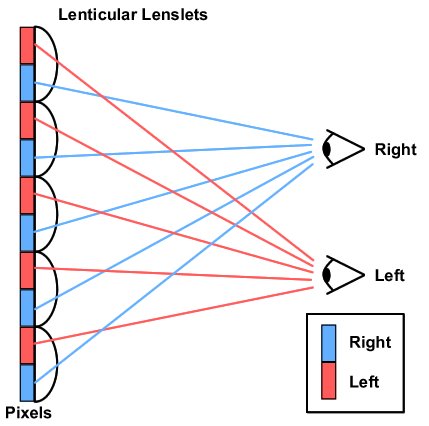3D and nothing more
The transition to the massive use of autostereoscopic displays on TVs and laptops is incredibly fast. Last summer, the first 3D laptops appeared, for example, you can recall the Toshiba A665 model, supplied with a pair of shutter glasses, then this year at CES 2011 Toshiba introduced a prototype of a new laptop with 3D image support, for which glasses are not required. Obviously, progress in this area cannot be stopped, and a number of interesting solutions have already been developed that make it possible to level out such natural 3D flaws as loss of resolution, limited viewing angles, the appearance of “blind spots”, etc.

Autosterescopy, the construction of a three-dimensional visual image without additional equipment, has been used in scientific research since the beginning of the 80s, however, the transition to its mass use in consumer technology has been outlined only in the last few years.
The principle of operation of an autostereoscopic display, like other types of stereoscopic equipment, is built on the “deception” of the brain so that a two-dimensional image can be transformed into a three-dimensional: each eye sees different images designed to appear from two different viewing positions.
There are two main methods that provide volumetric autostereoscopic imaging: using the parallax barrier and biconvex lenses (lenticular lens).
The parallax barrier, in fact, is another additional integrated LCD screen with a grid of vertical opaque stripes that obscure the light from the lamp at certain pixels depending on the viewing angle. This technology, thanks to a layer of liquid crystals, allows you to switch to the usual two-dimensional mode.

When using biconvex lenses, the light is directed to a certain observation zone, which allows each eye to see a different image at an optimal distance.

Note that if earlier we were talking about two-parallax systems, then in new solutions, images are already viewed from nine directions.
So Toshiba Integral Imaging technology, developed on the basis of liquid crystal microlenses, provides the possibility of forming a frame in nine angles, similar to a stereo card. The lens, located in front of nine pixels that are reflected multiple times, directs the viewer's eye to one of them, which one depends on the angle of view. Thus, in accordance with the angle of view, the overall three-dimensional image is added. In addition, if before the viewer had to keep his head within a certain angle from the panel, now the panel itself adjusts the normal viewing range to match the position of the viewer.
And recently, Toshiba introduced a prototype tablet computer equipped with a 12.1-inch touch screen and six-axis accelerometer, which controls the movements and tilts of the laptop.

Autosterescopy, the construction of a three-dimensional visual image without additional equipment, has been used in scientific research since the beginning of the 80s, however, the transition to its mass use in consumer technology has been outlined only in the last few years.
The principle of operation of an autostereoscopic display, like other types of stereoscopic equipment, is built on the “deception” of the brain so that a two-dimensional image can be transformed into a three-dimensional: each eye sees different images designed to appear from two different viewing positions.
There are two main methods that provide volumetric autostereoscopic imaging: using the parallax barrier and biconvex lenses (lenticular lens).
The parallax barrier, in fact, is another additional integrated LCD screen with a grid of vertical opaque stripes that obscure the light from the lamp at certain pixels depending on the viewing angle. This technology, thanks to a layer of liquid crystals, allows you to switch to the usual two-dimensional mode.

When using biconvex lenses, the light is directed to a certain observation zone, which allows each eye to see a different image at an optimal distance.

Note that if earlier we were talking about two-parallax systems, then in new solutions, images are already viewed from nine directions.
So Toshiba Integral Imaging technology, developed on the basis of liquid crystal microlenses, provides the possibility of forming a frame in nine angles, similar to a stereo card. The lens, located in front of nine pixels that are reflected multiple times, directs the viewer's eye to one of them, which one depends on the angle of view. Thus, in accordance with the angle of view, the overall three-dimensional image is added. In addition, if before the viewer had to keep his head within a certain angle from the panel, now the panel itself adjusts the normal viewing range to match the position of the viewer.
And recently, Toshiba introduced a prototype tablet computer equipped with a 12.1-inch touch screen and six-axis accelerometer, which controls the movements and tilts of the laptop.
